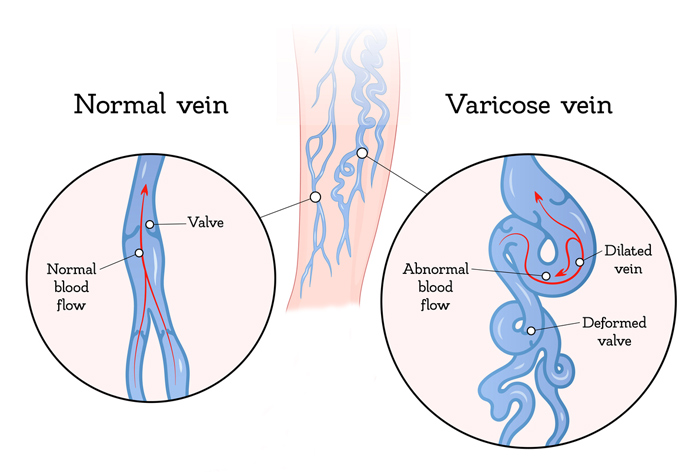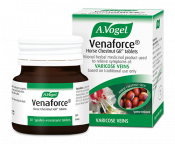Where can you get varicose veins?
Varicose veins occur when the valves in the veins become damaged as a result of swelling and stretching. This allows blood to flow backwards into the vein, causing further swelling, and sometimes leakages. These leakages pool into the surrounding tissues, causing varicose veins.
These veins most commonly appear in the lower legs. This is because the veins in this area have to work against gravity to push blood towards the heart. Long periods spent sitting or standing still can slow down blood flow, allowing blood to pool and forcing these veins to work harder to keep blood flowing.
However, in some cases varicose veins appear in other places around the body, including:
- Arms
- Pelvis
- Oesophagus
- Genitals
- Rectum.
1. Arms
Although the appearance of varicose veins on the arms is unusual, it can still happen.
Varicose veins occur in this area for the same reasons they do in the legs - damaged veins begin to swell and leak blood. They are less common in the arms, however, because the veins in the arms don't have to work as hard to get blood back to the heart, and they aren't working against gravity to the same extent as veins in the legs.
2. Pelvis
Varicose veins can also appear internally in the pelvic area, also known as Pelvic Venous Congestion Syndrome (PVCS).
This affects veins in the pelvis area and around the ovaries. It can cause chronic pain in the lower abdomen and may sometimes lead to visible varicose veins on the vulva or inner thigh.
Top tip: Ensure you get plenty of exercise to boost your circulation. This could be running, cycling or swimming, or even something gentler such as walking or yoga.
If you tend to sit at a desk all day, or spend long hours standing, try to keep blood flowing through your legs by doing simple exercises. Bending and stretching the knees, or flexing the ankles from time to time, can help improve circulation.
Read our article on leg exercises to do at your desk for more tips.
3. Oesophagus
Oesophageal Varices are varicose veins in the oesophagus. This kind of varicose vein is usually caused by liver damage. This damage, or cirrhosis, is often the result of excessive alcohol consumption or viral infections such as hepatitis.
Scarring in the liver can cause blood flow to slow down, which can increase the pressure in the veins around the stomach and oesophagus. The veins in the oesophagus are close to the surface and, if they rupture, they can begin to bleed, which can be dangerous.
Top tip: To avoid varicose veins in the oesophagus that are the result of cirrhosis, try to cut down on alcohol intake as this can prevent unnecessary damage to the liver.
4. Genitals
Varicose veins can sometimes appear on both male and female genitals.
During pregnancy, women are naturally more prone to varicose veins and, in some cases, these veins appear on the genitals. This is because the increasing weight of the baby puts pressure on the veins in the pelvis. Plus, during pregnancy, the volume of blood in your body increases, which puts pressure on the veins. In addition, an increase in the hormone progesterone during pregnancy causes blood vessels to relax, making it easier for them to stretch and swell.
The appearance of varicose veins on male genitals is also surprisingly common. These are called varicoceles and appear in the scrotum.
About 15% of the male population have a varicocele, usually developing between the ages of 15 and 25.1 They are not usually serious, but it has been noted that a varicocele can, in some cases, decrease sperm count and quality, occasionally resulting in infertility.2
Top tip: Elevating the affected area, if possible, can help. For example, if your varicose veins affect your genitals or rectum, elevating your hips slightly while lying down (using a few pillows) aids blood flow back to the heart.

5. Rectum
Varicose veins of the rectum and anus are also known as haemorrhoids. These often occur during pregnancy for the same reasons that varicose veins can appear on the vulva and vagina - increased pressure from the heavy baby and increased volume of blood, and the relaxing of veins due to progesterone.
These kinds of varicose veins can also appear in people who aren't pregnant. The most common cause in this case is excessive straining, for example, straining on the loo because of constipation.
Top tip: In the case of haemorrhoids, try to relieve constipation by drinking plenty of water and eating plenty of fruit, vegetables and high fibre foods.
When to see a doctor
It is best to speak to your GP about what treatment options are available if your varicose veins are worrying you, or are causing discomfort and pain. The range of treatment options for varicose veins is detailed on our treatments page.
References
1 https://www.ncbi.nlm.nih.gov/pmc/articles/PMC4770482/
2 https://www.ncbi.nlm.nih.gov/pmc/articles/PMC2658802/
Originally published on 12 August 2016 (updated on 14th November 2019).
Results: Where do you experience varicose veins?










